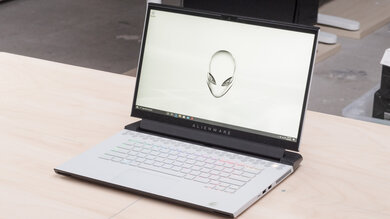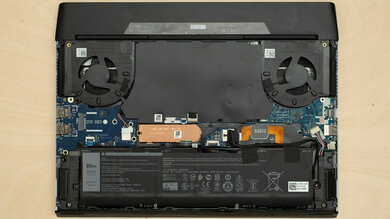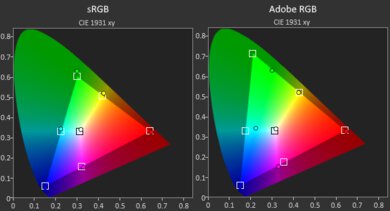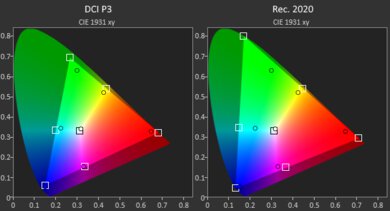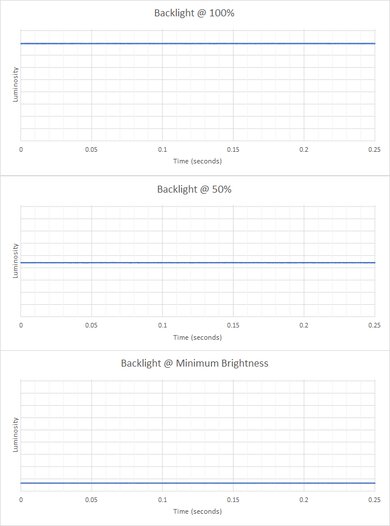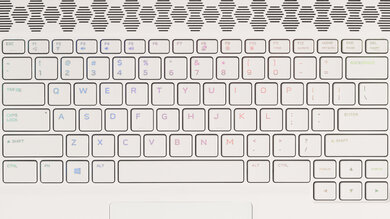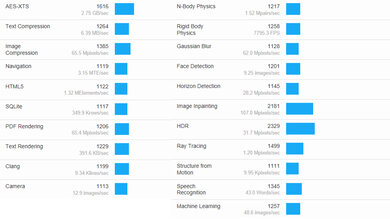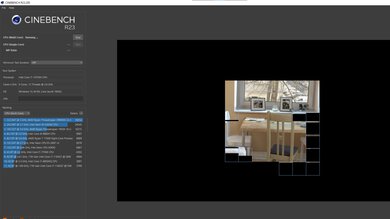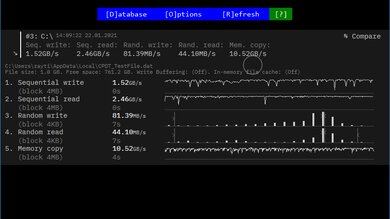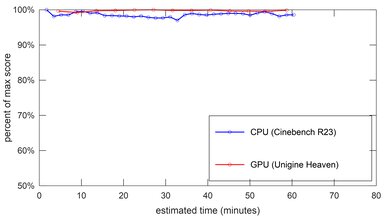The ASUS X515 is a budget Windows laptop with a 15.6 inch display. It has an all-plastic construction that feels reasonably well-built, with a thin and light design that makes it very portable. Its full-size keyboard includes a numpad and provides an okay typing experience; however, its lack of backlighting makes it hard to use in dark settings. Unfortunately, the screen looks dim and washed out, and the webcam doesn't capture any fine details due to its low resolution. Also, its battery doesn't last long enough to get you through a typical 8-hour day, and although it has a USB-C port, you can't use it to charge the laptop or connect an external display. Its Intel 10th Gen processor and integrated graphics can handle light workloads like web browsing and video playback with ease, but it isn't ideal for heavy tasks like video editing or 3D rendering. On the upside, it doesn't get overly hot or throttle under load.
Our ASUS X515 has a 720p TN display, an Intel Core i3-1005G1 CPU, Intel UHD Graphics for 10th Gen processors, 8GB of RAM, and 256GB of storage. If you need more processing power for heavier workloads or better multitasking, you can upgrade the CPU to an Intel Core i5-1035G1 or i7-1065G7 as they have more cores and threads. There are entry-level NVIDIA discrete GPUs available; however, the performance gain they provide over integrated graphics is minimal and will likely shorten battery life.
Our Verdict
The ASUS X515 is mediocre for school use. It feels reasonably well-built despite an all-plastic chassis, and its thin and light design makes it easy to bring around. However, its short battery life means you have to carry the charger as well. Unfortunately, the screen is too dim for use in well-lit settings, the keyboard lacks backlighting, and the webcam video quality is bad. Its Intel 10th Gen processor and integrated graphics can handle most student workloads like text formatting and web browsing, but they aren't powerful enough for demanding tasks like 3D rendering.
-
Very portable due to thin and light design.
-
Handles reflections well.
-
Display doesn't get bright enough to combat glare.
-
Short battery life.
-
CPU can only handle light workloads.
-
USB-C doesn't support charging or video output.
The ASUS X515 is inadequate for gaming. It's only available with a low-power Intel 10th Gen CPU, coupled with an integrated or entry-level discrete GPU, which aren't powerful enough to handle graphically demanding games. It also has a 60Hz panel with a slow response time and no VRR support. On the bright side, it doesn't get too hot or throttle under load, and its internals are easy to access should you want to upgrade the memory or storage.
-
Easy to access internals for upgrades or repairs.
-
Doesn't throttle under load.
-
CPU can only handle light workloads.
-
Only available with integrated or entry-level discrete GPUs.
-
60Hz refresh rate and no VRR support.
-
Slow response time causes noticeable ghosting.
The ASUS X515 is inadequate for media consumption. Its 720P TN panel looks dim, washed out, and inaccurate, with narrow viewing angles that make it unsuitable for sharing content. It also has a poor contrast ratio, so it isn't the best for dark room viewing. The speakers sound good but don't get very loud, and the battery only lasts long enough for one or two movies at most.
-
Very portable due to thin and light design.
-
Handles reflections well.
-
Screen looks dim and washed out.
-
Short battery life.
-
Low contrast makes blacks look gray in dim settings.
The ASUS X515 is sub-par for use as a workstation. You can only configure it with a low-power Intel 10th Gen CPU, along with integrated graphics or an entry-level NVIDIA discrete GPU, which aren't ideal for demanding workloads like video editing and 3D rendering. Additionally, its port selection is mediocre because you can't use the USB-C port for charging or video output, and its HDMI port is limited to the HDMI 1.4 standard. Its NVMe SSD is very fast, though, and it doesn't get overly hot or throttle under load.
-
Easy to access internals for upgrades or repairs.
-
Doesn't throttle under load.
-
CPU can only handle light workloads.
-
Only available with integrated or entry-level discrete GPUs.
-
USB-C doesn't support charging or video output.
The ASUS X515 is mediocre for business use. It has a thin and light design that makes it easy to carry around for business trips. However, its battery life is short, which means you have to plug it in at some point in a typical 8-hour workday. Unfortunately, it has a dim screen that isn't ideal for well-lit settings, its keyboard only provides an okay typing experience, and its webcam's video quality is bad due to its low resolution. It also has a mediocre port selection because its USB-C port doesn't support charging and video output, and its HDMI port is limited to the HDMI 1.4 standard.
-
Very portable due to thin and light design.
-
Handles reflections well.
-
Easy to access internals for upgrades or repairs.
-
Display doesn't get bright enough to combat glare.
-
Short battery life.
-
CPU can only handle light workloads.
-
USB-C doesn't support charging or video output.
- School
- Gaming
- Multimedia
- Workstation
- Business
- Updated May 16, 2023: Added mention of the ASUS Vivobook 16 M1605 (2023) as an alternative with a better build in the Build Quality section.
- Updated Mar 24, 2023: Added mention of the Acer Aspire 3 15 (2023) as an alternative with a better port selection in the Ports section.
- Updated Jan 13, 2022: Review published.
- Updated Jan 10, 2022: Early access published.
- Updated Dec 01, 2021: Our testers have started testing this product.
- Updated Nov 26, 2021: The product has arrived in our lab, and our testers will start evaluating it soon.
Differences Between Sizes And Variants
We tested the ASUS X515 (model X515J) with an Intel Core i3-1005G1 CPU, Intel UHD Graphics for 10th Gen Intel processors, 8GB of RAM, and 256GB of storage. The display, CPU, GPU, memory, storage, and color are configurable; you can see the options in the table below. There are other CPU options available, including Intel Celeron, Pentium, and Intel 10th Gen Comet Lake CPUs. However, our performance tests focus only on the Intel 10th Gen Ice Lake processors for conciseness.
Note: Some retailers advertise this laptop as the ASUS Vivobook X515, but ASUS doesn't. The Vivobook laptops are entirely separate models. ASUS replaced the X515 lineup with newer Intel 11th Gen models (X515M) in 2021.
| Screen |
|
|---|---|
| CPU |
|
| GPU |
|
| Memory |
|
| Storage |
|
| Color |
|
Our display and performance results are only valid for the configuration that we tested. If you come across a different configuration option not listed above, or you have a similar ASUS X515 laptop that doesn't correspond to our review, let us know, and we'll update it. Some tests, like black uniformity and color accuracy, may vary between individual units.
You can see our unit's label here.
Compared To Other Laptops
The ASUS X515 (2020) and the Dell Inspiron 15 3000 (2020) are very similar Windows laptops. The Inspiron 15 offers a better user experience because its keyboard is more comfortable to type on, the touchpad has better tracking, and its webcam has better video quality. It also has better serviceability, making it easier to upgrade the memory and storage after purchase. The X515 has a USB-C port which the Inspiron 15 lacks, but it only supports data transfer, meaning you can't use it for charging or video output.
The Lenovo IdeaPad 3 15 (2021) is much better than the ASUS X515 (2020) for most uses. The IdeaPad 3's build feels sturdier, its screen gets brighter to combat glare, and it displays more accurate colors out of the box. Also, its keyboard provides a better typing experience, its touchpad is more responsive, and its webcam captures a better image for video calls. The IdeaPad 3's AMD processors have much better multi-thread performance than the Intel CPUs on the X515 to handle heavier workloads, and they're more power-efficient, resulting in longer battery life.
The ASUS Vivobook 16 M1605 (2023) is much better than the ASUS X515 (2020). The Vivobook 16 has a sturdier build, providing a better user experience as it has a more comfortable keyboard with backlighting, a larger and more responsive touchpad, and a much better webcam. Also, it's available with newer and faster CPUs, and its battery lasts longer.
The ASUS X515 and the ASUS VivoBook Flip 14 (2020) are both budget Windows laptops. However, the VivoBook Flip is a 2-in-1 convertible that you can use as a tablet, while you can only use the X515 in clamshell mode. The X515 has a larger display, better-sounding speakers, and a better port selection. It also has a faster storage drive that significantly improves performance. On the other hand, the VivoBook Flip has longer battery life, and it remains silent under load because it has a fanless design.
The ASUS X515 (2020) and the Apple MacBook Air 13 (M1, 2020) are very different. The X515 is a budget 15.6 inch laptop that runs Windows, while the MacBook Air is a premium 13 inch laptop that runs macOS. The MacBook Air is better for the most part because it offers a superior user experience. The MacBook Air's touchpad is larger and more responsive, its keyboard provides a better typing experience, and its display is sharper, brighter, and more colorful. It also has better-sounding speakers and a significantly better webcam. The MacBook Air's M1 SoC is much more powerful than any of the Intel CPUs available on the X515, and it's also more power-efficient, leading to longer battery life.
The Lenovo IdeaPad Flex 5 14 (2020) is much better than the ASUS X515 for most uses. Although the IdeaPad Flex has a slightly smaller display, it has a 360-degree hinge that lets you use the laptop as a tablet, while you can only use the X515 in clamshell mode. The IdeaPad Flex's keyboard provides a better typing experience, its touchpad has better tracking, and its webcam captures more details due to its higher resolution. The IdeaPad Flex also has longer battery life, and it can be configured with Intel or AMD CPUs, while the X515 is only available with Intel processors.
The ASUS X515 (2020) and the Acer Aspire 5 15 (2020) are very similar 15.6 inch budget Windows laptops. The Aspire 5 provides a better user experience because it has a keyboard that's more comfortable to type on for long periods, the touchpad has better tracking, and its webcam has a higher resolution to deliver a more detailed image. The Aspire 5 also has a better port selection because its HDMI 2.0 port supports 4k @ 60Hz video output.
The ASUS X515 (2020) is a Windows laptop that can only be used in regular clamshell mode, while the HP Chromebook x360 14 (2021) is a 2-in-1 convertible device that runs Chrome OS. The HP provides a better user experience that's likely better for school or business use as it feels significantly sturdier, its keyboard has more travel and better-quality keys, its touchpad tracks significantly better, and its webcam and microphone are better. Also, the HP's battery lasts much longer. On the other hand, you can get the ASUS with significantly better-performing internals, including a quad-core Intel Core i7 CPU, dedicated entry-level NVIDIA GPUs, and much faster PCIe NVMe SSDs. You can get both laptops with much better-performing 1080p IPS displays if you don't like the 720p TN panel option.
The Lenovo IdeaPad 5 15 (2021) is better than the ASUS X515 (2020) for most uses. The Lenovo has better build quality as it sports a full-aluminum chassis, and its battery lasts more than 2 hours longer for light productivity. It also has a brighter screen to combat glare, a more comfortable keyboard, and a much better webcam for video calls. The Lenovo laptop's Intel 11th Gen CPUs perform better than the ASUS' Intel 10th Gen processors, so they can handle heavier workloads and provide a snappier desktop experience. Both laptops have dedicated NVIDIA GPU options, but they don't perform much better than the Intel CPU's integrated graphics.
Test Results
The ASUS X515 is a basic-looking laptop with a plastic chassis. It has a full-size keyboard with a numpad on the right side, so the touchpad is shifted to the left, which some people might not like. The bezels are fairly thin on the sides and the top, although the bottom chin is much thicker, with an ASUS branding in the middle. There are exhaust vents on the left side and the bottom of the laptop, and the speakers are also on the bottom. It's available in four color schemes: Slate Gray, Transparent Silver, Peacock Blue, and Silver.
The ASUS X515's build quality feels alright. It has a full plastic construction that feels somewhat cheap, with a finish that scratches easily, though not from fingernails. There's a good amount of flex in the display and bottom panel, but almost none when the laptop is closed. If you want a similar laptop with better build quality, check out the ASUS Vivobook 16 M1605 (2023).
The hinge is disappointing. Although it feels smooth with little to no play, the screen still wobbles a lot when typing, especially when using the laptop on an uneven surface.
The ASUS X515 is a thin and light laptop that's easy to carry around. The power adapter is also compact and should fit easily into most bags.
The ASUS X515's serviceability is good. It's easy to access the internals as you only need to remove some Philips screws and unclip the bottom panel with a prying tool. There's only one memory slot, so even though the RAM is user-replaceable, you can only run it in a single-channel configuration. There's room for a 2.5 inch storage drive, but the mounting cable isn't included in the box. As such, we consider it as non-upgradeable. You can replace the M.2 NVMe SSD, though. Opening and making changes to the hardware may void the manufacturer's warranty.
- ASUS X515 laptop
- 45W power adapter
- Documentation
The ASUS X515 has three display options: a 720p TN, a 1080p TN, and a 1080p IPS panel. We recommend getting a model with a 1080p IPS panel because a 720p resolution is too low for this screen size, and TN panels generally have worse viewing angles and color reproduction.
As expected for a budget productivity laptop, the ASUS X515 has a basic 60Hz refresh rate with no VRR support. It also has a slow response time causing visible ghosting, which isn't ideal for gaming or viewing fast-moving content. We expect the 1080p panels to perform similarly.
Our ASUS X515's 720p TN panel has a poor contrast ratio, resulting in blacks that look gray in dim settings. We expect the 1080p TN panel to be similar. The 1080p IPS panel is likely better, but not by much. The contrast ratio can vary between units.
The 720p TN panel on our ASUS X515 has mediocre screen brightness. It doesn't get bright enough to combat glare, so it isn't ideal for well-lit environments. However, it gets very dim at the lowest brightness setting, providing a more comfortable viewing experience in the dark. ASUS advertises the 1080p TN panel as having the same maximum brightness, but the 1080p IPS panel is brighter, with an advertised brightness of 250 cd/m².
The ASUS X515 has good reflection handling. Its matte anti-reflective coating works well in reducing the intensity of reflected lights, although you can still see some reflections even with the screen at maximum brightness.
Our ASUS X515's TN panel has awful black uniformity. The bright spots at the top and bottom of the screen are caused by the TN panel's poor viewing angles. We expect the 1080p IPS panel to have better uniformity. Black uniformity varies between individual units.

Our ASUS X515's TN panel has poor horizontal viewing angles. Image accuracy degrades very quickly as you move off-center, so you have to look at the screen almost straight on for the best picture quality. The 1080p IPS panel will have much better viewing angles.

Our ASUS X515's TN panel has terrible vertical viewing angles. The image looks especially bad from below because TN panels suffer from chroma inversion. You have to look at the screen straight on to get an accurate image, so you don't have much leeway to tilt the screen. The 1080p IPS panel will have much better viewing angles.
The ASUS X515 has awful color accuracy out of the box. Most colors are inaccurate due to the panel's narrow color gamut, and the white balance is also visibly off at most brightness levels. The color temperature is much cooler than our 6500K target, giving the image a slight bluish tint. The gamma doesn't follow the sRGB curve at all, making most scenes appear darker than they should. Color accuracy varies between units.
The ASUS X515 has a poor color gamut. It doesn't even have full coverage of the commonly-used sRGB color space, making most content look washed out. It also has very limited coverage of wider color spaces like Adobe RGB, DCI P3, and Rec. 2020. We don't recommend using this display for color-critical work or viewing HDR content. The 1080p TN and 1080p IPS panels are advertised to have the same 45% NTSC coverage.
The ASUS X515's backlight is entirely flicker-free at all brightness levels, which helps reduce eye strain for some people.
The ASUS X515's keyboard is disappointing. It provides a passable typing experience as the keys are stable, well-spaced, and have a good amount of travel. However, the plastic keycaps feel cheap, and there's no backlighting. If you want a laptop with a better keyboard, check out the Lenovo IdeaPad 5 15 (2021).
The touchpad is acceptable. It doesn't stutter, but it doesn't track accurately near the edges of the touchpad, and actions like drag and drop or double-tap clicks don't work at times. Also, the plastic material feels cheap, and the click mechanism only works in the bottom half of the touchpad.
The ASUS X515 has good speakers. They have a good amount of bass extension for laptop speakers, but the treble drops off pretty early, and the dip in the high-mid frequencies makes vocals sound slightly distant. Unfortunately, they don't get very loud.

The ASUS X515 has a bad webcam. It has a very narrow field of view, and due to its low resolution, the image looks soft with almost no fine details. The image is also overexposed, making colors look washed out. The microphone sounds loud and clear, although voices sound a little nasal, and there's some static in the background. Some models have a 720p webcam, which we expect will perform better. If you want a similar laptop with a better webcam, check out the Lenovo IdeaPad 3 15 (2021).
The ASUS X515 has a mediocre port selection. The USB-A port on the left side supports USB 3.2 Gen 1 standard (up to 5Gbps data transfer rate), but the two on the right side only support USB 2.0 (up to 480Mbps). The USB-C port is also USB 3.2 Gen 1, and you can only use it for data, meaning you can't use it for video output or charging. There's a slot for a Kensington lock on the right side. If you need a similar laptop with a USB-C that supports charging and video output, check out the Acer Aspire 3 15 (2023).
The ASUS X515's wireless adapter is an Intel Wireless-AC 9461.
Our ASUS X515 has an Intel Core i3-1005G1 CPU, a low-power processor designed for thin and light laptops. It can handle simple tasks like web browsing, video playback, and other general productivity workloads like text formatting. However, it isn't powerful enough for demanding tasks like video editing or 3D rendering. If you have a slightly heavier workload or tend to have multiple programs running simultaneously, you can upgrade to the Intel Core i5-1035G1 or i7-1065G7 for better performance, as they have double the number of cores and threads. The Intel Core i7-1065G7 is faster than the i5-1035G1 on paper, but the difference in performance is likely minimal due to thermal limitations.
The ASUS X515 is available with an integrated or discrete GPU. The Core i3 and i5 CPUs have Intel UHD Graphics for 10th Intel processors as its integrated graphics processor, while the Core i7 has Intel Iris Plus. Although the i7's Intel Iris Plus performs better than the Intel UHD Graphics, none of them are ideal for graphically intensive workloads like gaming or image processing. The discrete GPU options include the NVIDIA GeForce MX130 and MX330 with 2GB of GDDR5 VRAM. They perform slightly better than the Intel CPUs' integrated graphics, especially in VRAM-heavy applications, but they're still entry-level discrete GPUs that aren't powerful enough to provide a smooth experience in demanding games or hardware-accelerated applications like video editing software.
You can configure the ASUS X515 laptop with 4GB or 8GB of RAM. We recommend 8GB because 4GB is very limiting and can cause some stutters or slowdowns. Unfortunately, while the RAM module is user-replaceable, you can only run the memory in a single-channel configuration because there's only one slot, which impacts performance in applications that benefit from a higher bandwidth.
There are many storage options available. You can configure the laptop with a PCIe NVMe SSD, a physical SATA hard drive, a combination of both, or an SSD with Intel Optane memory. We recommend getting a model with an SSD because installing the operating system on a physical hard drive will significantly impact performance. You can add the 2.5 inch SATA drive yourself after purchase; however, ASUS doesn't include the mounting cable in the box, so you'll have to get it from a third party. As for Intel's Optane memory, it can boost performance in some instances because it acts like an extra cache memory, but the gain is likely minimal because the NVMe SSD is already very fast.
Our ASUS X515 with an Intel Core i3 has middling performance in Geekbench 5. It performs amazingly well in single-thread workloads, but its multi-thread performance is disappointing due to its limited number of cores and threads. This means it can handle simple tasks like web browsing, video playback, and text formatting, but it struggles in heavier workloads like 3D rendering. If you need to run multi-threaded applications or tend to have multiple programs running simultaneously, the Intel Core i5 and i7 will perform much better because they have double the number of cores and threads. As for the GPU compute, the Core i3's Intel UHD Graphics performs terribly, and we expect the Core i7's Intel Iris Plus and NVIDIA discrete GPUs to be only slightly better.
Our ASUS X515's Intel Core i3 performs reasonably well in Cinebench R23. Like the Geekbench tests, it has good single-thread performance, but its multi-thread performance is sub-par because it only has two cores and four threads. The Intel Core i5 and i7 will perform better, especially in multi-threaded rendering.
The ASUS X515 performs terribly in Blender, taking a long time to render the relatively simple bmw27 scene. The Intel Core i5 and i7 will be faster, but not enough for any practical purposes. We can't perform the GPU test because Blender doesn't support the integrated GPU, although we expect it to take even longer. The NVIDIA GeForce MX130 and MX 330 GPUs can complete the task faster than the CPU; we expect them to be within the same ballpark but a tad slower than the NVIDIA GeForce MX350 in the Acer Aspire 5 15 (2020).
The ASUS X515 performs very badly in the Basemark GPU benchmark, which is expected for integrated graphics. The Intel Core i7's Iris Plus and NVIDIA discrete GPUs can likely achieve playable frame rates in lighter or older titles, but not in modern, graphically-intensive AAA games.
The ASUS X515's storage drive performance is outstanding. It has fast read and write speeds that make the system feel very responsive, like when booting up the computer, launching apps, and transferring files. The SATA hard drive will be significantly slower, so it's best to get a model with an SSD as the main drive. The speed of the SSD may vary depending on the size, as larger SSDs tend to perform better.
The ASUS X515 has poor battery life. It only lasts a little over six hours of light productivity, and it's even shorter for video playback. Gaming shortens the battery life significantly, although it's still better than most gaming laptops with a power-hungry GPU. Models with an Intel Core i5, i7, or a discrete GPU will have shorter battery life. Battery life varies depending on usage.
Borderlands 3 isn't playable on our ASUS X515 with an Intel Core i3-1005G1. It's extremely choppy even at the lowest graphical settings, and we had to run the benchmark in DirectX 11 because it kept crashing on DirectX 12. Models with an Intel Core i7 or an NVIDIA discrete GPU will only perform slightly better.
Civilization VI runs terribly on our ASUS X515 with an Intel Core i3-1005G1. The average frame rate is so low that it doesn't even show up on our frame time graph, and the turn time is very long. It's playable at the lowest graphical settings, although you'll still see some occasional stutters. Models with an Intel Core i7 or an NVIDIA discrete GPU will perform better, but you still have to turn down some settings to achieve playable frame rates.
CS:GO is playable at high settings on our ASUS X515 with an Intel Core i3, but it's a bit choppy at times, which isn't ideal for an FPS game that requires precise aiming. It's much smoother if you turn the settings down to near minimum. Models with an Intel Core i7 or an NVIDIA GPU will perform better and get you a more stable 60fps at high settings.
Shadow of the Tomb Raider doesn't run on our ASUS X515 with an Intel Core i3-1005G1 at high settings. It only works at the lowest graphical settings, and even then, the average frame rate is too low to provide a good gaming experience. We also had to run the game in DirectX 11 because it kept crashing on DirectX 12. We expect the same result on the Intel Core i5-1035G1 models. The game will likely start on models with an Intel Core i7 or NVIDIA discrete GPU at high settings, but it won't be playable due to low frame rates.
The ASUS X515 has good thermal and noise performance. The keyboard is cool when idle, and the fan is near silent. The keyboard doesn't get uncomfortably hot under load, although the heat is centered around the Z and X keys, where most people rest their left hand. The fan is audible at full speed, but it isn't loud or distracting.
The ASUS X515's performance over time is superb. The CPU doesn't throttle even though it gets very hot, and there's no performance loss on the GPU either as the temperature is well within the normal range. The Intel Core i5 and i7 models likely throttle because higher clock speeds generally lead to more heat, but we expect the performance loss to be minimal.
The ASUS X515 ships with Windows 10S, a stripped-down version of Windows designed for low-end hardware. S mode generally runs smoother because it requires fewer system resources, but you can only install apps from the Windows Store. You can opt-out of S mode free of charge; however, this is a one-time switch, and you can't go back to S mode after activating the full version of the operating system. ASUS indicates that this laptop meets the minimum requirements for Windows 11.
The ASUS X515 has a couple of pre-installed software applications, including:
- MyASUS: This application optimizes the system and keeps the firmware up to date. It also lets you access some system settings and warranty information.
- AudioWizard: This application lets you customize the laptop speakers' sound profile and EQ settings.
- Disney+: Application for video streaming service.
- Microsoft Office: 30-day trial of Microsoft's Office Suite.
- Spotify: Application for music streaming service.


